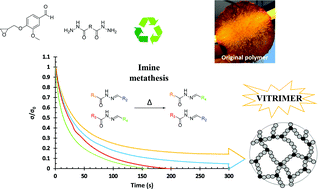Synthesis and characterization of new bio-based poly(acylhydrazone) vanillin vitrimers†
Abstract
New acylhydrazone vitrimeric-type materials have been studied. These materials can be efficiently relaxed, without the addition of an external catalyst, through an exchange process that has been confirmed as imine metathesis, which differs from the previously reported transimination process in linear polymers. This is the first article that develops vitrimers with high Tg and fast relaxation based on poly(acylhydrazone)s. These materials have been prepared by condensing stoichiometric amounts of glycidyl vanillin and aliphatic dihydrazides of different chain lengths. The curing reaction takes advantage of the different reactivity of formyl and glycidyl groups and proceeds in two sequential steps: a first condensation of the formyl group of vanillin with dihydrazide monomers at low temperature followed by reaction of the remaining hydrazides with the epoxide, which requires temperatures above 150 °C. The complete disappearance of the initial reactive groups has been confirmed by FTIR spectroscopy. The thermomechanical characteristics have been evaluated by DMTA, obtaining Tgs above 100 °C for the materials prepared, which present excellent vitrimeric features with very short relaxation times. Using model compounds, we were able to demonstrate that imine metathesis is responsible for the exchange process. The thermal stability of these materials has been rated by TGA. Poly(acylhydrazone) materials showed good recycling and self-healing abilities and could be hydrolyzed in an acidic medium.



 Please wait while we load your content...
Please wait while we load your content...